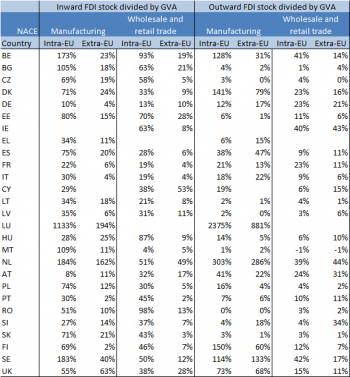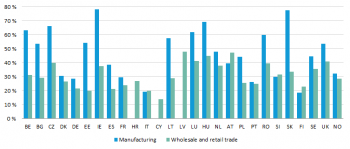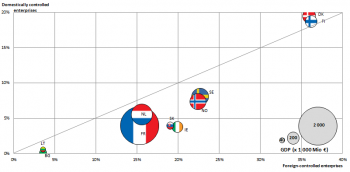Archive:Economic globalisation indicators in industry, wholesale and retail trade
- Data extracted in March 2015 Further Eurostat information, Main tables and Database.
In June 2014 Eurostat published a statistics explained article describing the construction of a set of economic globalisation indicators. Eurostat has extended this set of indicators along two dimensions. Firstly the indicators are calculated separately for their intra-EU and extra-EU partners and secondly the indicators are calculated separately for 12 NACE Rev. 2 sections of the non-financial business economy. This article shows graphs for some of the indicators in two NACE sections (Manufacturing and Wholesale and retail trade), illustrating the type of information which could be used to track the different aspects of globalisation.
Main statistical findings
We have economic globalisation indicators in five themes:
- International trade: Eexports divided by gross value added (GVA), imports divided by GVA and exports divided by imports
- Foreign direct investment (FDI): Outward FDI stocks, divided by GVA, inward FDI stocks divided by GVA and FDI flows intensity
- Employment: Share of foreign controlled employment in total domestic employment, growth rate of foreign controlled employment and growth rate of emploment of foreign affiliates in extra-EU countries
- Turnover: Share of foreign controlled turnover in total domestic turnover, growth rate of foreign controlled turnover and growth rate of turnover of foreign affiliates in extra-EU countries
- Research and development (R&D): Share of foreign controlled R&D expenditure in total domestic R&D expenditure
With some exception the indicators presented in this article show three main findings:
- Economic globalisation indicators are larger for intra-EU partners than for extra-EU partners.
- Economic globalisation indicators are larger for Manufacturing than for Wholesale and retail trade.
- Economic globalisation indicators are larger in smaller countries than in larger countries.
Economic globalisation indicators are larger in smaller countries
Larger countries tend to have a greater variety of resources and therefore have less need for international trade. Another factor favoring trade for smaller countries is that they tend to have lower transport costs for international trade than larger countries. For these two reasons we would expect smaller countries to be more globalised that larger countries.To investigate this claim we have calculated the correlation coefficients with the size of economies expressed in GVA for 7 of the 13 globalisation indicators (see table 1). These are broken down by partner (intra-EU/extra-EU) and economic activity (Manufacturing/Wholesale and retail trade).
Since our claim is that smaller countries are more globalised we would expect the correlation coefficient to be negative. Indeed in Manufacturing 13 out of 14 of the correlations are negative, confirming our claim. Also in Wholesale and retail trade 8 of 12 of the correlation are negative. The exceptions are the outward FDI-stock both intra and extra-EU and the extra-EU share of foreign controlled employment and turnover. Another observation from the table is that this inverse relationship between globalisation and country size is stronger for intra-EU partners than for extra-EU partners. This is the case for all seven of the indicators in Manufacturing and for five of the six indicators in Wholesale and retail trade.
International trade
Table 2 shows the exports and imports of goods divided by GVA and the ratio of exports to imports by country. At first sight it seems strange to find ratios of more than 100% in exports and imports divided by GVA. However there is no contradiction because GVA is calculated using net exports (exports – imports). Thus whenever exports and imports are large compared to domestic consumption, investment and government expenditure these indicators can very well have values of more than 100%.
When we compare intra and extra EU figures for exports and imports we see that almost always the intra-EU figures are higher than the extra-EU figures underlying the importance of the internal market. The exceptions have been coloured green. The few countries that are exceptions are Greece, Spain, Malta, Finland and the United Kingdom although none of them is an exception for all combinations of exports/imports, manufacturing/trade and intra-EU/extra-EU. They all tend to be on the outside of the EU and therefore are likely to have important extra-EU trading partners.
Comparing manufacturing to wholesale and retail trade we see a clear difference in the export and import figures of these sectors. Manufacturing typically has larger shares in exports confirming our second main finding. However in Wholesale and retail trade typically the shares in imports are larger than in exports . A possible explanation is that in Manufacturing, countries in the EU tend to import relatively cheap raw materials and intermediate products while exporting more expensive final products whereas in Wholesale and retail trade the opposite is true.
The combined effect of lower imports and higher exports in Manufacturing causes for most countries a negative trade balance whereas in Wholesale and retail trade the opposite is true. This can clearly be seen in the last four columns of the table where exports are divided by imports, mostly giving values higher than 100% for Manufacturing and lower than 100% for Wholesale and retail trade.
Foreign direct investment
The foreign direct investments from and to EU countries divided by GVA are shown in table 3. Just as for imports and exports, we find for that intra-EU investments divided by GVA are generally higher than extra-EU. This is more prominent in inward investments (first four columns) than in outward investments (last four columns). Comparing FDI between Manufacturing and Wholesale and retail trade we see that in general FDI as a percentage of GVA is bigger in Manufacturing than in Wholesale and retail trade. This seems to be especially the case for most of the larger economies with the exception of Germany.
When comparing inward and outward investments we see that for most countries intra-EU inward investments are larger than outward investments whereas for extra-EU it is the more often the other way around. Since we are looking at aggregated partners (extra-EU and intra-EU) this could be due to the distribution across the different countries. It seems however that mirror discrepancies in FDI statistics also play a role.
Differences between small and large economies give a more mixed picture for FDI than they do for imports and exports. As expected large economies such as France, Germany and Italy have low ratios of FDI stocks to GVA but other large economies such as Spain and the United Kingdom have fairly high ratios. It is not clear whether these differences are due to economic phenomena or due to regulatory differences.
Foreign controlled employment and turnover
When through foreign direct investments an enterprise controls 50% or more of votes in another enterprises it controls that enterprise. Figure 1 and 2 respectively show the foreign controlled share of employment and turnover in total domestic employment and turnover. The pattern for both is obviously quite similar; countries that have high foreign controlled shares of employment also have high foreign controlled shares of turnover. For almost all countries the shares are higher in Manufacturing than in Wholesale and retail trade, and when the opposite is true the differences are small.
When comparing both figures we see that for almost all countries the foreign controlled shares in turnover are bigger than the shares in employment. The unweighted average for the employment shares is 29% in Manufacturing and 18% in Wholesale and retail trade. For turnover these shares are 47% and 31% respectively. Logically this means that the for domestic controlled enterprises the shares in turnover must be smaller than the shares in employment, suggesting a higher rate of turnover to employment in foreign controlled enterprises.
In table 3 the shares have been broken down by intra-EU and extra-EU. As before for imports, exports and FDI, in most countries both foreign controlled employment and turnover have higher values for intra-EU than for extra-EU partners . For the few countries where the opposite is true we see that the differences are quite small for Germany and Italy but noticeable for Ireland, Luxembourg and the Netherlands (both intra-EU and extra EU) and the United Kingdom (only intra-EU).
As before larger countries generally have higher shares of foreign controlled employment and turnover than smaller countries although there are exceptionson both sides. For the larger countries an exception is the United Kingdom which for a large country has high shares whereas for the smaller countries examples are Finland and Portugal which both have low shares.
Foreign controlled research and development (R&D)
R&D statistics of foreign controlled enterprises are collected for the NACE-sections B to F of the non-financial business economy. In those sections the availability is highest for section C, Manufacturing of which the statistics are shown in figure3.
Shares vary a lot between countries, we find share of over 60% for Slovakia, Czech Republic and Hungary and shares of under20% for Finland, Portugal and Estonia. Of the larger European economies we see that Germany and France have relatively low shares of around 20% whereas the United Kingdom has a share that is relatively high (58%) with Spain (39%) in between. Therefor the assumption that large countries have small shares is only partly true.
The three countries with the highest share in intra-EU expenditure in 2011 (Slovakia, Czech Republic, Hungary) are member states that joined the EU in 2002. In contrast in Extra-EU expenditure among the four countries (United Kingdom, Netherlands, Slovakia and Austria) with the highest share, three are older member states.
Further Eurostat information
Publications
- Foreign affiliates statistics - employment by business function
- Microdata linking - international sourcing
- International sourcing of business functions
- International_trade, investment and employment as indicators of economic globalisation
- International sourcing statistics
- Global value chains - international sourcing to China and India
- Features of International Sourcing in Europe in 2001-2006 - Statistics in focus 73/2009
- International Sourcing in Europe - Statistics in focus 4/2009
- Plans for International Sourcing in Europe in 2007-2009 Statistics in focus 74/2009
Dedicated section
Methodology / Metadata
- Foreign affiliates of EU enterprises - outward FATS (ESMS metadata file — fats_out_esms)
- Foreign controlled EU enterprises - inward FATS (ESMS metadata file — fats_esms)
- European Union direct investments (ESMS metadata file — bop_fdi_esms)
- International trade (ESMS metadata file — ext_esms)
Source data for tables, figures and maps (MS Excel)
Other information
- Commission communication COM/2010/0612 final Trade, Growth and World Affairs Trade Policy as a core component of the EU's 2020 strategy - European Commission, 2010





